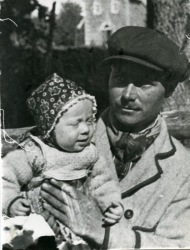Rooslaid, Peeter 





Peeter Rooslaid (comes from the Ulas-family, before Estonianization known as Peter Schönberg; 20 July 1891 Ruhnu – 15 December 1976 Kihnu), a craftsman, silversmith, artist and musician.
Ruhnu wife Marta Melders and since 1936 Maria Rooslaid from Kihnu (1909–97).
In the autumn of 1944 when most of the Ruhnuswedish people left for Sweden, he stayed in Ruhnu with his wife. He was arrested in 1949 and spent 3.5 years in Tallinn Patarei prison; thereafter he spent 6 months in Krasnojarsk. During the Soviet times, he and his wife took care of the Ruhnu church. His wife Maria was the director of Ruhnu public house. They moved to Kihnu in 1969. Kihnu museum of local history has dedicated an exposition to him.
He made beautiful and personal silver breastpins and brooches (e.g. the silver brooch with a Viking ship). In 1926, a more than 200-year-old seal gun, which had a silver-plate graved on it was given to the Swedish king Gustav V who visited Tallinn. He also invented a unique compass, which had a round disk with readings instead of the usual needle. This kind of compass was especially handy on a voyage in case of a fierce storm because the ship bearing was also in front of the steersman. They have been used by Estonian fishermen but they also reached Latvia and via refugees and tourists also to Sweden.
He has made water colours and drawings of Ruhnu island in the book by the German ethnographer Ernst Klein published in Sweden in 1924. Property marks of Ruhnu farms have been marked mainly with his help. He performed in weddings and played the violin in village feasts.
Maria and Peeter Rooslaid are buried at Kihnu cemetery.
His father Elias Schönberg (born in 1861 in Ruhnu) was a musician, shoemaker and silversmith. He was also the best choral folk representative on the island and sang by the Swedish hymn-book from 1695. In 1938 the Swedish Radio recorded 12 pieces performed by the violinist Elias Schönberg in the parsonage of Ruhnu church. Schönberg was almost blind during the recording and had forgotten the words, thus, he sang only six songs.
His son Elias Schönberg (born in 1921 in Ruhnu) was also a silversmith. He underwent the military service in Ruhnu lighthouse, after that he worked as a telecommunications operator. In 1942 he married his Ruhnu wife Maria Smens (1923–2001). The family left for Gotland in 1944 where they bought a farm. He worked in the Slite cement factory as a mechanic and translator; he continued making silver jewellery, which is valued also among Swedes. Maria was known as a traditional craftsman. In 2002 Schönberg gave the museum of Saaremaa over a couple of hundred garments used in Ruhnu from which most of them had belonged to his wife.
Created in 2013


 1920_S.jpeg)



